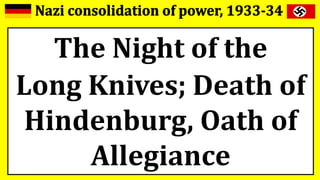
Consolidation of Nazi Power - night of the long knives, death of hindenburg, oath of allegiance
- 1. The Night of the Long Knives; Death of Hindenburg, Oath of Allegiance
- 2. Hitler was increasingly powerful within Germany. His control of the police and security forces meant most were scared to challenge him. However Hitler worried that he faced rivalry from within his own party and supporters. He took violent action to end this possibility.
- 3. Hitler’s power in Germany was strong but not absolute. The Enabling Act meant that the Fuhrer controlled Germany, but Hitler feared being removed as Fuhrer. Hitler was also concerned that the Army had not sworn allegiance to him.
- 4. Hitler's key worry was the SA. Led by Ernst Rohm, they were a revolutionary group. Their two million members meant they were bigger than the army. Rohm had suggested merging his SA with the Reichswehr, creating a powerful group. It was claimed he was plotting a second revolution to achieve socialism in Germany.
- 5. By 29 June 1934, Hitler had decided to take action to stop any potential opponent to his power. He secured the support of the army to tackle the SA. Hitler sent members of the SS to kill his rivals. Over two days (29th-30th June), the SS carried out arrests of SA leaders, and other rivals to Hitler.
- 6. Men such as former Chancellor Kurt von Schleicher, Nazi organiser Gregor Strasser and SA leader Ernst Rohm were arrested. Others close to Vice- Chancellor Papen were targeted. Some were shot during the purge, others were bludgeoned to death. Rohm refused to commit suicide and was shot.
- 7. The total death rate from the Night of the Long Knives is debated. At the time estimates ranged from up to 1000 people killed, but generally the figure is now agreed to be around 90. Hitler had been advised to take these actions by the Italian fascist leader, Benito Mussolini.
- 8. News of the purge began to spread, but Goebbels prevented newspapers from publishing lists of the dead. It was claimed Hitler had stopped an attempted coup. On 3 July 1934, Hitler and then the Cabinet then agreed a law which made the Night of the Long Knives a legal act.
- 9. On 13 July 1934, Hitler addressed the Reichstag. This was the first time Germans were officially told about the events in June. Hitler said that those killed had been involved in treason against Germany. He also warned that other people doing likewise would face the same fate.
- 10. The Night of the Long Knives helped Hitler secure his control of Germany. The army praised his actions, and he was also given the support of President Hindenburg. Many ordinary Germans believed the rumour that Schleicher and Rohm were working with France.
- 11. On 2 August 1934, just over one month after the Night of the Long Knives, President Hindenburg died, aged 86. Hindenburg had been a national hero, and Hitler had faced some limits on his power. Now that Hindenburg was dead, this was no longer the case.
- 12. The day before Hindenburg’s death, on 1 August 1934, Hitler knew that the President was close to death. Thus the Cabinet passed a law that after Hindenburg’s death the offices of Chancellor and President would be merged. Hitler then became head of state and the head of government.
- 13. Hitler held a referendum on 19 August 1934, asking the German people if they agreed with merging the roles of President and Chancellor. 90% voted yes. In passing this law, Hitler had actually violated the Enabling Act, which said that he could not interfere with the Presidency.
- 14. Leaders of the army hoped that with a weakened SA, they would have a stronger influence in Germany. It was proposed that, after Hindenburg’s death, soldiers should make an oath of allegiance to Hitler. The Generals hoped this would mean that both groups were formally linked.
- 15. After the President’s death, the army made an oath of personal loyalty to Hitler. However instead of increasing the army’s power it simply undermined the Generals and emphasised Hitler’s power. Instead the SS became the most powerful of the military forces in Germany.
- 16. Historians’ views • Stephen Lee: The SA were the true revolutionaries and the purge was an attempt by Hitler to consolidate his own power. • Dick Geary: The 30 June purge increased Hitler’s popularity as it showed that the Nazi state “would brook no opposition”. • Roderick Stackelberg: Despite “the extra-legal nature” of the purge and its brutality, “many Germans regarded it as evidence that the Nazis repudiated the extra-legal violence of the SA”. • Michael Burleigh: The purge showed Hitler’s contempt for the law in retrospectively legalising mass murder.